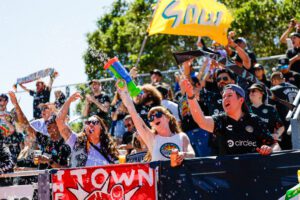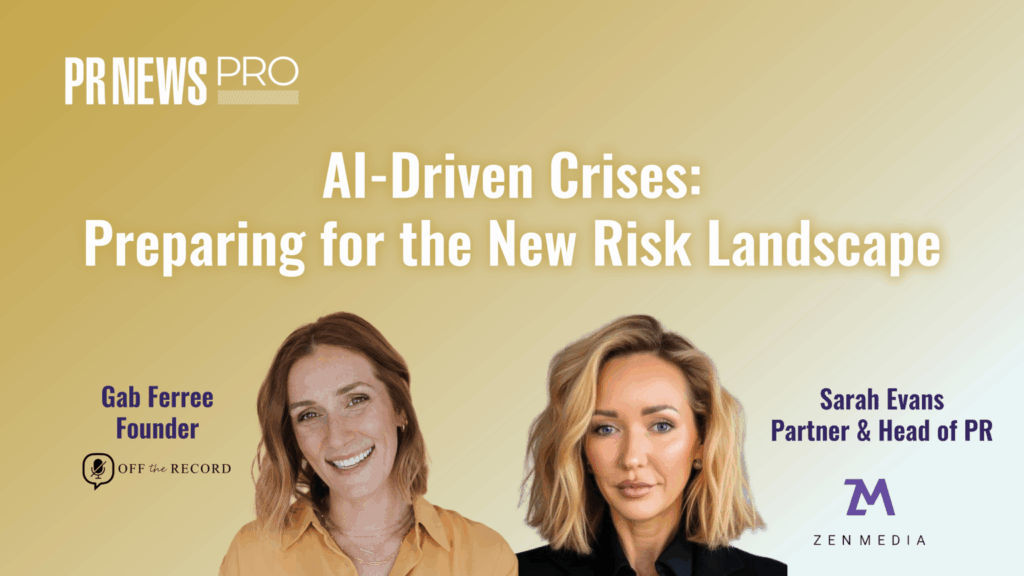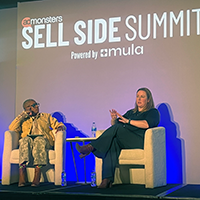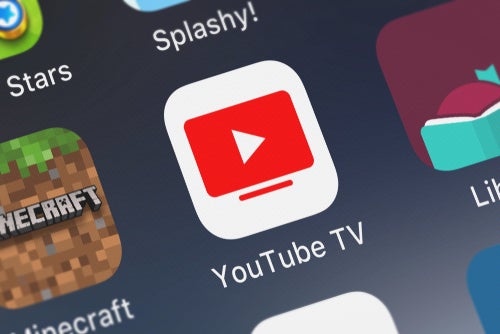Planning to “pop-up" in Cincinnati? Hand out 5,000 samples at a grocery store? Teach people how to use a hand-held’s music service at a concert? It’s all about to begin as the event-marketing season gets underway. And even though you might be in the final planning stages, it’s not too late to pack up a few lessons from the experts. Here’s eight tips, tricks and takeaways to add to your file.
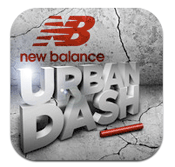 1. Events need clear links to a sale Engagement around an experience or event for the brand should lead to a potential sale. Here’s a great example: The New Balance Urban Dash. When the brand opened a new experience store on Fifth Avenue in Manhattan, it needed to get people there. The store itself is an event. Visitors can learn about the history of the brand or have customer shoes made on site, as well as multiple other inter-activities.
1. Events need clear links to a sale Engagement around an experience or event for the brand should lead to a potential sale. Here’s a great example: The New Balance Urban Dash. When the brand opened a new experience store on Fifth Avenue in Manhattan, it needed to get people there. The store itself is an event. Visitors can learn about the history of the brand or have customer shoes made on site, as well as multiple other inter-activities.
The “Urban Dash” is an app that dropped a digital baton someplace in the city every day, several times a day for one month. Users went to those locations and when the player got within 100 feet would receive the baton as a virtual icon on their phones. They then had to run to the store to claim a prize. But there was a catch that created a sense of urgency to get people to the store: Players could track other players’ movements. If the one player got within 100 feet of another player who had already captured a baton, that player could steal it.
“Everything led to the store,” Jeff Froud senior vice president planning and perspective at promotional agency TPN, said.
2. New Consumption Occasions Use demonstrations to engage and counsel people on new ways to consume or use your products, which drives new occasions to buy. If you haven’t thought of at least one new use for your product, now’s the time.
“We see a growing trend in the role events play in linking products to new consumption occasions,” Bobbi Merkel, senior vice president-convergence, at TPN said.
Take Nature Sweet. Its SunBursts tomatoes are relatively unknown. Their yellow skins makes consumers unsure of the taste and even less sure about how to use them. To directly communicate with the target audience—40-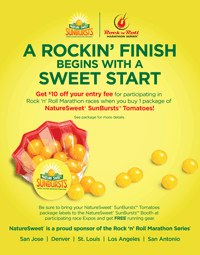 year-old highly educated and ambitious females—it signed on as a sponsor to stage events at six Rock ‘n’ Roll Marathons. More than 100,000 samples and 25,000 coupons were distributed with the message that tomatoes aren’t just for salads, but for “sweet” healthy snacking. More than 2,000 consumers signed up for recipes and coupons at the expo booths. In stores, messages on packaging and P-O-P offered $10 off the entry fee for the marathon when they bought one package of SunBursts. The events were supported by online, retail events, social media and retail rewards.
year-old highly educated and ambitious females—it signed on as a sponsor to stage events at six Rock ‘n’ Roll Marathons. More than 100,000 samples and 25,000 coupons were distributed with the message that tomatoes aren’t just for salads, but for “sweet” healthy snacking. More than 2,000 consumers signed up for recipes and coupons at the expo booths. In stores, messages on packaging and P-O-P offered $10 off the entry fee for the marathon when they bought one package of SunBursts. The events were supported by online, retail events, social media and retail rewards.
“Four out of 10 shoppers choose a brand once inside the store,” Froud said. “They might know the particular category, but the physical brand that actually ends up in their shopping court happens in store. The most effective touch point is a demonstration or sample of a product that puts that person within arms reach of the sale.”
3. The Big One Big events will not go away. Remember Target’s “vertical fashion show” several years ago to unveil its fall fashion collection? Acrobats danced their way down a “runway” on the side of a nine-story building on 5th Avenue in Manhattan in sight of Rockefeller Center. The press coverage was more than Target could ask for. The catch? Target didn’t even have a store in Manhattan. Think big and let the press do the rest of the work for you.
4. Is Sampling Dead? The notion of distributing thousands, if not millions, of samples, within split seconds to consumers rushing has taken a sharp turn. The challenge has become: How do you extend that 5-second encounter to a one-, two- or even 10-minute highly interactive experience?
“The days of coming in and having a taste test are gone,” Chris Caldwell, senior vice presidentat Team Epic, said. “You need a much deeper, engaged experience. It’s not just one person you’re engaging with. It’s that person’s entire network. The idea is to attempt to turn these consumers into brand advocates.”
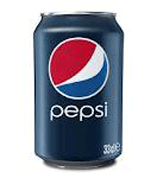 Pepsi is moving in this direction. Instead of stimulating trial or repeat purchase by handing out 3 million samples over the course of a particular period in one location, the sampling is now incorporated into broader experiences: a mobile marketing tour or interactive event.
Pepsi is moving in this direction. Instead of stimulating trial or repeat purchase by handing out 3 million samples over the course of a particular period in one location, the sampling is now incorporated into broader experiences: a mobile marketing tour or interactive event.
And don’t think social media isn’t elbowing in as a way to distribute samples while virtually interacting with consumers at the same time. This may not be face-to-face contact, but it’s where a lot of your potential customers are hanging out.
5. The importance of one individual Every social platform you have at your disposal should be incorporated into every aspect of the event, from planning to get people hyped for what’s to come, to during the event to encourage postings and viral sharing, to post-events to continue the conversation. How marketers communicate around events is a different game, they no longer control the conversation.
“You’ve got to evolve from a look at quantity of impressions to quality of impressions,” Caldwell said. It used to be where one individual was worth one individual—give them a razor or a can of soda—but now the importance of one individual is so expanded that we have to spend more time with them with a more quality engagement because that person is going to impact 100 more. Each exposure is more valuable than it used to be, each individual is a mini network. It’s no longer about trial or sampling, it’s about experience.”
6. You Can’t Own Everything But you’ve got to own something. When you talk about sponsorships, you talk about events and experiences that support those sponsorships. But sponsorships are crowded with sponsors, and because, most often, you can’t be the only one, the messaging, the creative, the promotions all have to be well linked to the brand— its business and fan base—so that it’s easy for people to make the connection to the sponsorship, not only at the event, but well beyond the activities as well.
One standout example is FedEx. It has sponsored the National Football League for 11 years. As FedEx was looking to introduce ground service years ago, it tied the service to its NFL sponsorship by introducing the very successful “Air and Ground” campaign. More recently, FedEx introduced office and freight by a continuing air and ground and adding “special teams” to continue the football metaphor.
“The beauty of this is that people get it instantly, but it has also evolved as the business has evolved,” said Dave Grant, principal, Team Epic. “You can’t own any other those things but it’s critically important to put a stake in the ground and own it.
To tie this all to events, FedEx and Team Epic put on “NFL Open Houses” at stadiums on non-game days. Hundreds of FedEx’s best customers are invited to go onto the field, into the locker rooms, hear about FedEx service and meet a running back or quarter back.
“It’s the ultimate trade show, entertainment slash fandemonium,” Caldwell said.
7. The complete experience Put the focus on the complete experience, not just the tactical components of the event—the pop-up tent, the vehicle. A strong strategy around the event should be tied into the complete marketing mix to support what’s on the ground, Eric Addeo, managing director of experiential services at Revolution, said.
8. The new event staffer Brand reps hired for events are now selected for their social media, photography and videography skills because of the demand for appealing content from the event. They are interviewed about how well they understand the brand, its history, its character and uses. Many are required to have a marketing degree and make an appearance in front of the chief marketing officer. That’s an about face from hiring event people who can just put up a tent and smile.
“These people need to understand what the brand is trying to do on the ground, be technologically advanced, know how to Twitter, run a tablet and a digital video camera,” Addeo said. “They also have to live the life. If you’re sponsoring the FIFA tour, you hire soccer players to conduct guerilla style soccer tournaments. They need to know how to play the game.”
